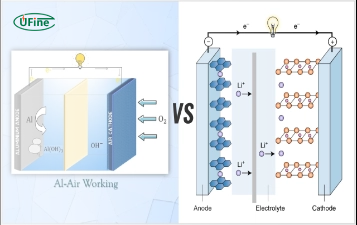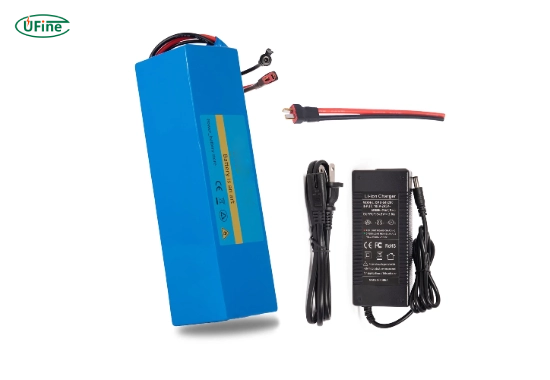Choosing the correct 48V battery for your e-bike is one of the most critical decisions for performance, safety, and longevity. But with so many options available, how do you pick the right one?
The best 48V battery for your e-bike depends on your motor size, usage, battery chemistry, capacity, and build quality. You must also consider compatibility, safety, brand reputation, and future support.
This guide is written in a clear, human style to help you understand every part of the process. Whether upgrading or buying your first battery, this is your no-nonsense resource.
Part 1. What is a 48V e‑bike battery?
A 48V e-bike battery is a rechargeable power source designed to supply electricity to your electric bicycle. The “48V” refers to the battery’s voltage, which impacts how much power it can deliver to the motor.
Compared to 36V or 24V batteries, a 48V battery:
- Offers more torque and higher top speeds
- Performs better on hills and off-road terrain
- Supports mid to high-powered motors (500W–1000W+)
Most 48V batteries use lithium-ion (Li-ion) or lithium-iron phosphate (LiFePO4) cells. These types are known for their lightweight, high energy density, and long life cycles.
Artikel Terkait: The Ultimate Guide to Ebike Battery
Part 2. Why does voltage matter in e‑bike batteries?
Voltage is key in determining how much power your battery can simultaneously deliver. Think of it like water pressure in a hose—the higher the voltage, the stronger the “push” to the motor.
A 48V battery is ideal for:
- E-bikes with 500W to 1000W motors
- Riders who need strong acceleration
- Climbing steep hills or carrying heavy loads
- Throttle-based riding (not just pedal assist)
Using the correct voltage ensures efficiency and extends the life of your bike’s electrical system. Mismatched voltage can lead to overheating, system errors, or hardware failure.
Part 3. How to choose the right battery capacity?
Battery capacity, measured in amp-hours (Ah), determines how far you can ride on a single charge. The higher the Ah, the longer the range, but the heavier the battery.
| Battery Size | Typical Range | Best For |
|---|---|---|
| 10Ah | 20–30 miles | City commuting |
| 13Ah | 30–45 miles | Mixed terrain |
| 17.5Ah | 50–60+ miles | Long-distance, hilly routes |
Choose your battery capacity based on:
- How far do you ride on average
- Terrain (flat vs. hilly)
- Your weight and cargo
- Assist level (pedal-assist or throttle)
Reminder: Actual range can vary depending on wind, tire pressure, road conditions, and motor efficiency.
Part 4. What’s the difference between LiFePO4 vs. Li-ion 48V batteries?
When selecting a 48V battery, the cell chemistry matters. The leading options are Li-ion (Lithium-ion) and LiFePO4 (Lithium Iron Phosphate). Each has its advantages and trade-offs.
Li-ion (Lithium-ion)
Pros:
- The high energy density (more power in a smaller size)
- Lightweight
- Widely used and affordable
- Excellent performance in cold weather
Cons:
- Slightly shorter lifespan (500–1000 cycles)
- Less stable under high temperatures
- Requires proper battery management
LiFePO4 (Lithium Iron Phosphate)
Pros:
- Exceptional safety and thermal stability
- Longer lifespan (up to 2000+ cycles)
- More eco-friendly
- Performs better in high-temp conditions
Cons:
- Heavier and bulkier
- More expensive
- Lower energy density (less power per kg)
Verdict:
If weight and compact size matter more (e.g., folding bikes), choose Li-ion. If safety and longevity are your top concerns, LiFePO4 is worth the investment—especially for cargo or commercial e-bikes.
Part 5. What are the types of 48V battery packs?
E-bike batteries come in different physical styles and mounting options. Here are the most common for 48V systems:
1. Rear Rack Battery
Mounts on the bike’s rear cargo rack
Easy to install
Great for city bikes and cruisers
2. Down Tube Battery
Mounts on the frame’s down tube
Balanced weight distribution
Sleek and integrated look
3. Integrated Battery
Hidden inside the frame
Aesthetically clean
Usually more expensive and brand-specific
4. Triangle Battery Pack
It fits inside the bike’s triangle frame
High capacity, ideal for mountain bikes
Always check dimensions, connectors, and mounting brackets before purchasing a replacement or upgrade.
Part 6. How to match a 48V battery with your motor?
Match the battery to your motor’s voltage and wattage to avoid compatibility issues. A 48V battery typically works best with:
- 500W to 1000W motors
- Some 1500W motors, with appropriate BMS and discharge rate
- Controllers rated for 48V systems
Also, check:
- Discharge rate (continuous Amps)
- Connector type (XT60, Anderson, Bullet, etc.)
- Battery Management System (BMS) support
An underpowered battery can cause power drops, overheating, or controller damage.
Part 7. Should you buy a branded or generic 48V battery?
This is a critical decision. Not all batteries are made equal.
Branded Batteries (Samsung, LG, Panasonic Cells)
Pros:
- Reliable performance
- Higher safety standards
- Longer lifespan (3–5 years)
- Better BMS (Battery Management System)
Cons:
- Higher cost
- Sometimes limited customization
Generic Batteries
Pros:
- Lower price
- Easier to find
Cons:
- Lower-quality cells
- Shorter lifespan
- Inconsistent performance
- Higher failure risk
Looking for a custom solution?
Ufine Battery offers highly customized 48V lithium battery solutions tailored to your motor, range, and size requirements. Whether you need a unique shape, connector, or chemistry, Ufine can design a battery that fits your needs. Their batteries utilise premium cells and an intelligent BMS, providing both safety and performance.
Part 8. How to safely dispose of an old 48V e-bike battery?
Old lithium batteries are hazardous waste and should never be thrown in the trash. Here’s how to dispose of them safely:
- Do not puncture or damage the battery.
- Check with your local e-waste facility – many accept lithium batteries.
- Some bike shops or electronics retailers offer recycling programs.
- Tape the terminals to prevent short circuits during transport.
- Never burn or incinerate a battery—it can explode.
Proper disposal protects the environment and prevents fires or chemical leaks.
Part 9. How do you care for your 48V battery for a long life?
Battery maintenance is the key to performance and lifespan.
Do:
- Charge after each ride (but don’t leave charging overnight)
- Store at 50% charge if not used for over a week
- Keep in a cool, dry place
- Use the original charger
- Let the battery cool before charging after a ride
Don’t:
- Fully discharge regularly
- Expose to extreme heat or cold
- Overcharge or leave connected for days
A quality 48V battery can last 3–5 years or more with good care.
Part 10. How much should you spend on a 48V battery?
Here’s a general pricing breakdown:
| Battery Specs | Price Range | Notes |
|---|---|---|
| 48V 10Ah | $200–$300 | Entry-level, shorter range |
| 48V 13Ah | $350–$500 | Mid-range, best value |
| 48V 17.5Ah+ | $500–$800+ | Long-range, premium builds |
Invest in quality. A cheap battery may save money now but could cost you in repairs, replacements, or even safety issues.
Part 11. FAQs about 48V battery
What size 48V battery is best for a 750W motor?
A 48V 13Ah to 17Ah battery is ideal. It balances performance, range, and safe discharge rates.
Can I upgrade from a 36V to a 48V battery?
Only if your motor and controller support 48V. Otherwise, it could damage your system. Always check with the manufacturer.
What’s better: LiFePO4 or Li-ion for my e-bike?
Li-ion is lighter and better for most riders, but LiFePO4 lasts longer and is safer—ideal for commercial or heavy-duty use.
How do I know when to replace my battery?
If your range drops significantly or your battery won’t charge properly, it’s time to test or replace it. Most batteries last 500–1000 charge cycles.
How far can a 48V 17.5Ah battery take me?
On average, you can ride 50–60 miles with light pedal assist. Range depends on terrain, rider weight, and speed.
Related Tags:
More Articles

Aluminum Air Battery vs. Lithium‑Ion: Key Cost & Performance Differences
Aluminum air vs lithium-ion: non-rechargeable but high energy density vs. rechargeable and widely used in EVs, electronics, and storage systems.
Aluminum Air Battery Design: Materials, Assembly & Efficiency Tips
An aluminum air battery uses aluminum and air to generate power. Learn its materials, assembly steps, and tips to boost energy output and efficiency.
7 Advantages of a Heated Lithium Battery in Cold Climates
Looking to power batteries in freezing temps? Heated lithium batteries excel in cold climates. Here are 7 key benefits and how they work.
How to Choose the Best Floor Scrubber Battery for Commercial Cleaning?
Selecting the ideal floor scrubber battery ensures a long runtime, rapid charging, and minimal maintenance for efficient commercial cleaning operations.
Battery for Blower vs Battery for Leaf Vacuum: Which One Should You Choose?
Battery for blower vs leaf vacuum—learn the key differences in power, fit, and runtime to choose the right battery for your outdoor tool needs.




